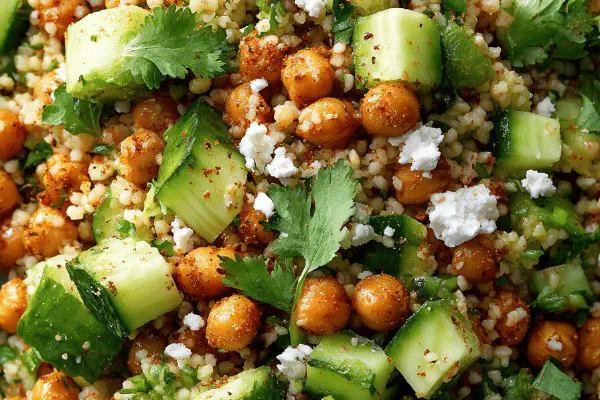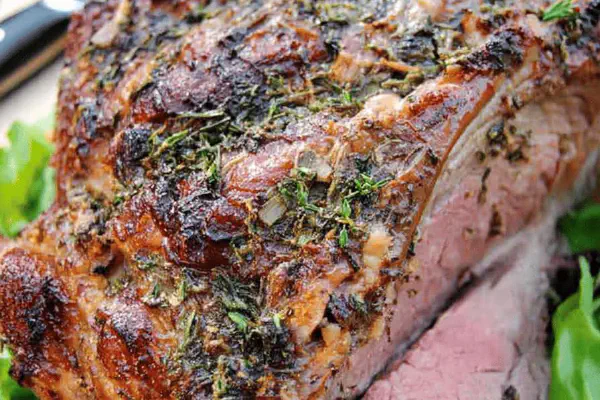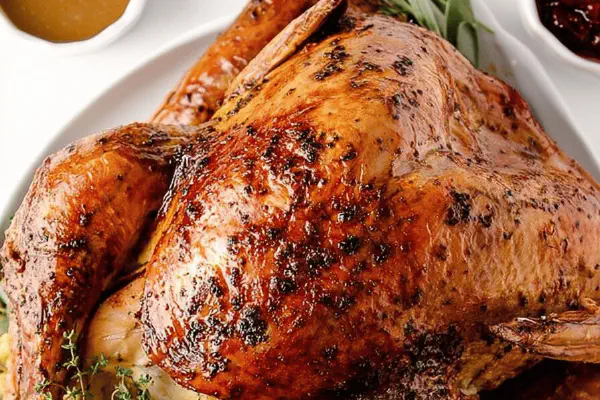Herb-Roasted Chicken Couscous

By Emma
Certified Culinary Professional
Ingredients
- 7 large carrots cut into 1 to 1.5 cm thick rounds
- 3 large onions quartered
- 3 cloves garlic peeled
- 25 ml vegetable oil
- 2 chickens roughly 1.9 kg each
- 150 ml herb seasoning blend, homemade or store-bought (parsley, thyme, rosemary, savory substitute)
- 1 can 400 ml chickpeas rinsed and drained
- 3 medium zucchinis diced
- 3 medium tomatoes diced
- 20 ml tomato paste
- 8 ml harissa paste
- 1.2 liters chicken stock homemade or low sodium
- 650 g couscous
About the ingredients
Method
- Set oven rack mid-level. Heat oven to 185°C. The slight dip from 190 prevents drying out in my experience.
- Scatter the carrots, onions, garlic tossed in oil and cracked black pepper in a large roasting pan. Use high-sided one for sauce later. Create a veg base that steams and roasts, develops caramel notes.
- Place a rack over the veggies so chicken juices drip into them. Rinse and pat dry the chickens. Rub half herb mix inside each cavity – don’t skimp, it infuses slowly. Then rub remaining herbs all over breasts and thighs. Let rest 15 minutes uncovered. It lets skin tack up for roasting crisp.
- Slide chickens breast-side up on rack. Roast uncovered for about 1 hour until skin looks golden but not deeply brown. Look for bubbling juices in cavity – signals heat is reaching center without drying meat. Timings can vary; poke thickest part if unsure, feels firm but springy.
- Remove rack with chickens from pan. Set rack on baking sheet to catch drips. Stir chickpeas, zucchini, tomatoes, tomato paste, harissa and half the stock into vegetables underneath. This infusion during second roast adds moisture, layers of acidity and heat.
- Nestle chickens back on rack over saucy vegetables. Roast 40 to 50 minutes more until internal temp reads 79°C to 82°C near the bone but not touching it. Touch test of thigh – should be tender, juices clear. No pink inside. This slower finish keeps meat juicy, prevents dryness.
- Rest chickens 10 minutes after roasting. This step lets juices redistribute. Don’t skip or meat dries out immediately once carved.
- Bring remaining stock to boil in a pot. Remove from heat and pour in couscous. Cover tightly; no peeking for 6 to 7 minutes to absorb steam. Fluff with fork gently so grains separate. Couscous that steams like this has a light fluffy texture without clumps.
- Carve chickens into breasts and thighs. Transfer meat and vegetable sauce to large platter or serve family style bowls. Spoon couscous alongside.
- Taste sauce – add salt, pepper or drizzle olive oil for brightness if desired. Fresh herbs sprinkled on top just before serving brighten flavors and add contrast.
Cooking tips
Chef's notes
- 💡 Use oven temp as cue. Dropping from 190 to 185°C slows skin browning; keeps meat moist. Watch juices bubbling in chicken cavity for doneness, not just clock. Midroast veggie addition prevents dryness, adds acidity layering. Toss chickpeas, zucchini, tomato paste with stock under chicken; merges flavors. Rest chicken uncovered before roasting to help skin crisp. High-sided roasting pan avoids drips escaping during second stage. A rack elevates bird; juices drip into veg not pooling so skin stays firm.
- 💡 Herb rub inside cavity sinks slowly, don’t skimp. Fresh parsley and thyme blend well, but dried herbs work fine to avoid waste. Sub rosemary with savory or oregano if herb availability varies. Oil choice matters. Use vegetable oil for roasting energy resistance. Olive oil burns at high heat; drizzle fresh olive oil after cooking to brighten. Harissa adds slow heat, start with less for layering spice later. Tomato paste thickens sauce and adds acidity; no close substitute for texture and color.
- 💡 Couscous needs tight cover, no peeking for full steam absorption. Fork fluff grains gently, don't mash or stir in hot broth or grains clump. Stock volume covers veggie simmering and couscous soaking; top up with water if short but expect dilution. Chickpeas rinse well to reduce sodium, canned preferred for convenience. Carrots and onions roast until caramel patches appear; smell of roasted garlic key aroma sign. Use rack to avoid soggy bottom on chicken skin and catch drippings for sauce depth.
- 💡 Use sensory cues over strict timing. Thigh test—poke thickest part; firm but slightly springy, juices clear, no pink visible. If unsure, probe temp 79 to 82°C near bone but not touching. Moving chicken during midroast to stir sauce ingredients and veg helps deglaze pan, meld flavors, and prevent drying. Rest chicken 10 minutes after heat off, in pan lightly covered or uncovered depending on skin crispness desired. Couscous texture relies on steam time not stirring; too long or stirring leads to clumps or mush. Prep veggies slightly thick to hold shape during slow roasting and simmering.
- 💡 Moisture control key; midroast sauce addition rehydrates the veg base. Tomatoes diced fresh or canned chopped for time savings; canned with juice can thin sauce. Harissa can be swapped with smoked paprika plus cayenne if heat unwanted. Sub turkey for chicken if crowd size demands, watch cooking times and thermometer closer; larger birds need longer. Flavors evolve from slow heat and layering textures—soft veg, tender meat, light couscous—no rushing. One-pan roasting plus one pot limits cleanup; keep utensils minimal and check in early stages for caramelization development.
Common questions
How to know if chicken is done without temp?
Poke thickest part of thigh. Should feel firm but with a bit of give. Juices run clear, no pink. Skin golden but not burnt. Listen for bubbling juices inside cavity—means heat reached center slowly. If in doubt, cut open small test slit near bone.
Can I substitute harissa paste with something milder?
Yes. Go for smoked paprika plus pinch cayenne for heat control. Harissa gives spice and complexity; paprika adds smoky notes and depth. Adjust amounts to taste. No chili? Try mild chili powder with a little lemon zest for brightness.
What if I don’t have fresh herbs?
Dried herbs work fine—parsley, thyme, rosemary dried versions. Use sparingly since dried more potent. Oregano or savory can substitute rosemary in a pinch. Herb rub inside chicken cavity needs coverage—don’t skimp as heat will slowly pull flavors in. Fresh herbs sprinkled at end brighten dish visually and on palate.
How to store leftover chicken and couscous?
Keep them separate if possible. Chicken cool, wrap in foil or airtight container. Couscous stores in fridge covered. Reheat chicken gently—oven or pan to avoid drying. Couscous prefers quick steam cover in microwave or skillet with splash water to revive fluffiness. Leftovers last 3-4 days packed tight. Avoid reheating multiple times.



